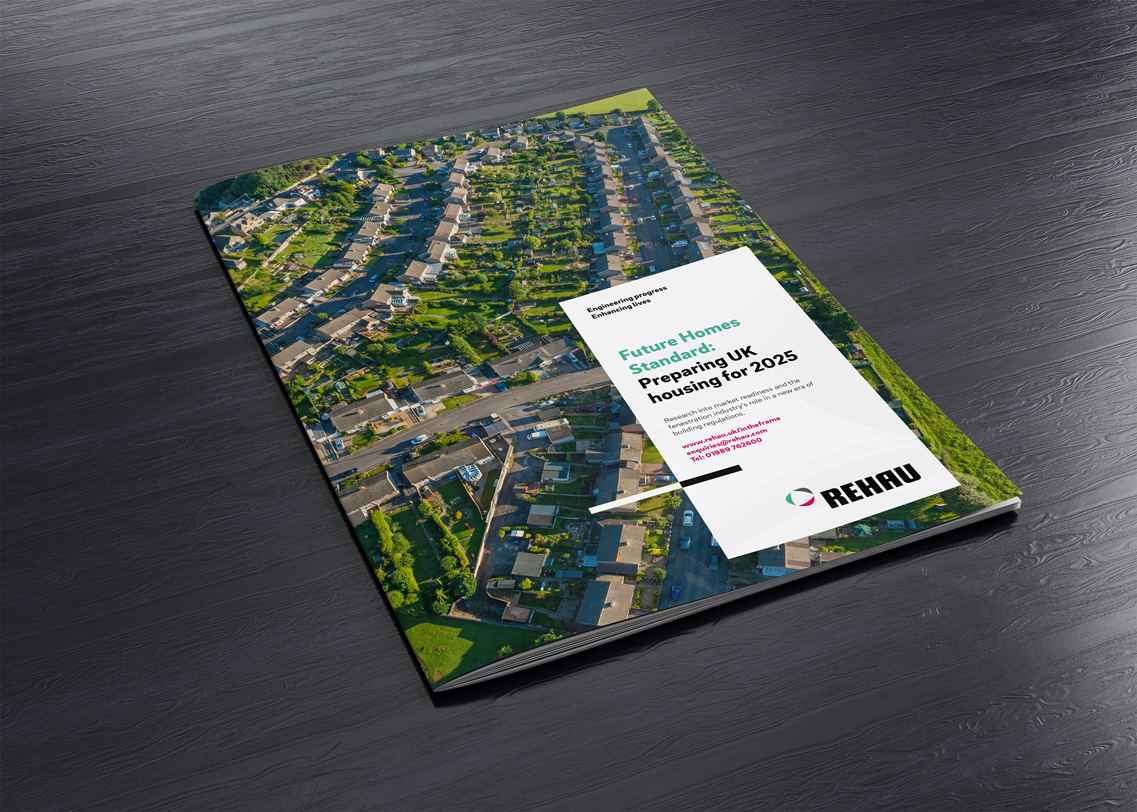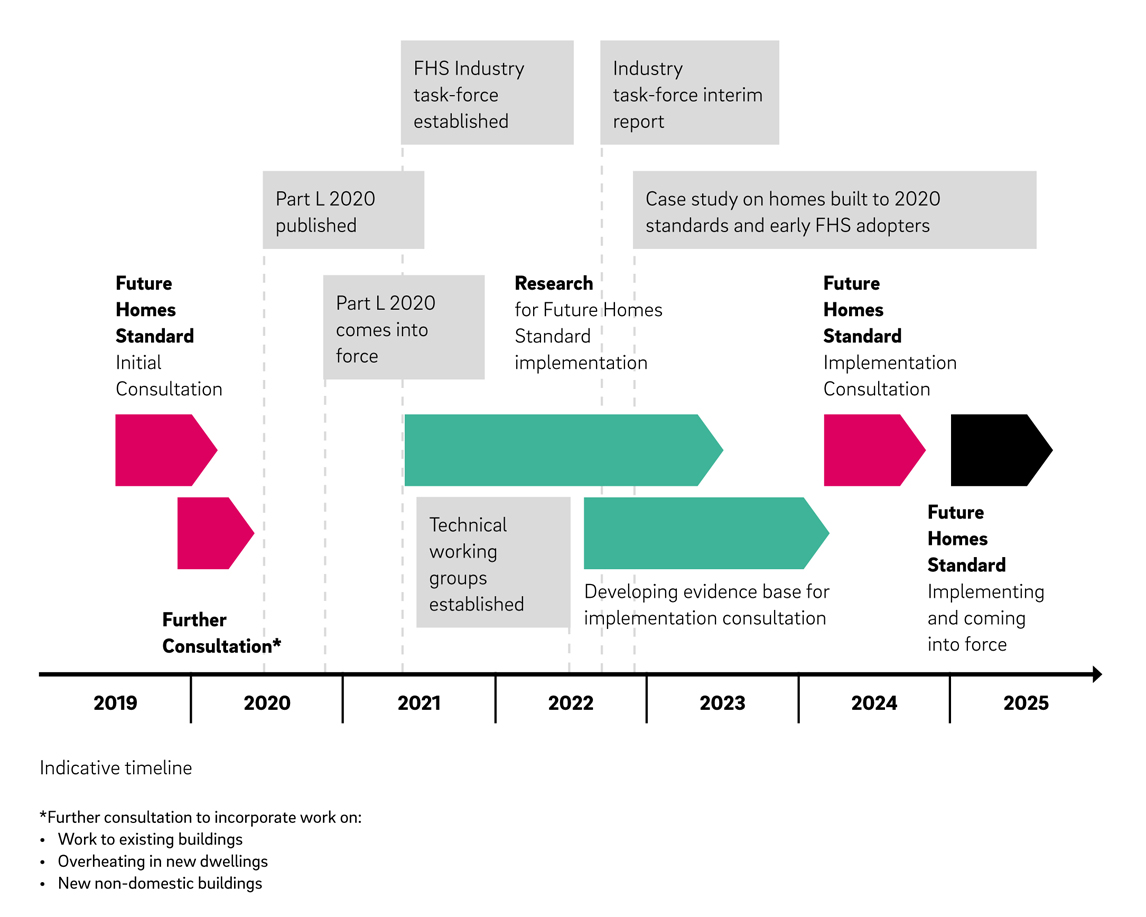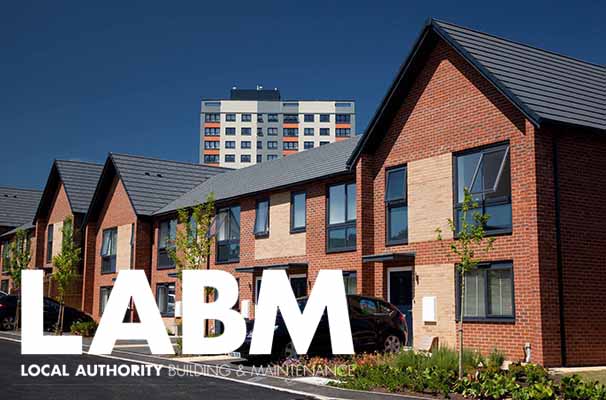
When it comes to decarbonisation, the UK social housing sector is facing a huge undertaking. The Future Homes Standard is set to accelerate progress, but its complexities, scope and timescales can prove challenging to stakeholders on new or retrofit housing projects. With the full rollout just a year away, REHAU UK‘s CEO, Martin Hitchin, explores what social housing stakeholders need to do to stay ahead of the curve on these all-important regulations.
The Future Homes Standard (FHS) has been much trailed, yet adjustments made to Part F and L of the Building Regulations in 2022, focusing on ventilation and energy efficiency, continue to drive debate in the social housing sector, but even as stakeholders continue to get to grips with these uplifted standards and how they affect new-build and retrofit projects, it must be noted that these updated requirements were an interim measure. The FHS will be adopted in full from the start of 2025, putting further pressure on local authorities.
Despite the upheaval it poses to construction projects, it cannot be denied that its goals are laudable. Ensuring all new homes emit 75-80% less carbon than earlier benchmarks is paramount if the social housing sector is to remain on-track with the legally mandatory goal of net zero emissions by 2050. Yet it will take an unprecedented effort to achieve, even before existing buildings are factored in.
Indeed, with reports suggesting that 80% of current properties will still be in use by 2050[1], and that most public housing was constructed between 1945 and 1980[2], construction professionals have their work cut out. The facts are simple — these buildings were not designed with net zero in mind, so while upgrades are necessary, ensuring they are effective and FHS-compliant will require close collaboration across the supply chain.
Countdown to compliance
Yet with 2025 looming, it’s alarming that over two-thirds of the sector seem unprepared for the new uplifts. This alarming statistic is detailed in the Future Homes Standard: Preparing UK Housing for 2025, the latest market readiness report from polymer solutions provider REHAU. Based on a survey of 200 decision makers across the housing industry’s various sectors conducted by the company’s independent research partner Censuswide, 79% of respondents said meeting the current FHS timeline would be ‘somewhat challenging’ or ‘very challenging’.
Though these findings are eye-opening, social housing’s status as publicly owned property means the spotlight is on these estates to evolve to meet increasingly rigorous sustainability regulations. As such, sector stakeholders must adapt to meet standards imposed by the FHS. Awareness of all housing components and the role they play in meeting the upcoming regulations will be key to this.
 Building understanding
Building understanding
However, as REHAU’s latest whitepaper underlines, there is still work to do if the sector is to meet its FHS obligations post-2025. For example, despite windows having a major impact on building ventilation and thermal efficiency, none of the respondents surveyed could confidently say they knew of a frame system that could achieve the required FHS U-value of 0.85 W/M2K.
Specifically, 65% said ‘no’ when asked, and the remaining 35% were uncertain. With the FHS’s full implementation only a year away, this is clearly worrying and will require cooperation throughout the supply chain to resolve. Also, it must be noted that awareness of the standard is not the issue — it is simply that housing stakeholders believe meeting its requirements will be hard, and solutions are not obvious.
This too is reflected in the report’s data, where 76% of respondents working on new-builds said the current timeline presented challenges for the industry. Though all survey participants noted factors such as ‘cost’ and ‘supply chain issues’ as other concerns, it is significant that ‘insufficient technical understanding’ was cited as the main concern for new-build stakeholders.
These uncertainties may become further exacerbated by recent government revisions to building energy efficiency standards. Though the changes announced by the Prime Minister at October’s Conservative Party Conference do not directly impact the FHS, watering down previous national green energy commitments may shake the sector’s confidence around sustainability legislation and what they include.
Growing concerns can already be seen in comments from the National Home Decarbonisation Group, which recommended the Government reaffirm its green commitments by allowing the full release of the £3.8bn Social Housing Decarbonisation Fund in the Autumn Statement.[3] With a year to go until the FHS’s full implementation, any additional changes could further affect clarity over what precisely the social housing sector needs to do to decarbonise.
 The path forward
The path forward
To reiterate, the sector expressing concern about its readiness for the FHS is not a sign of any shortcomings or reluctance to engage with the standard. The changes it sets out are transformational for the nation’s residential building stock and industry best practices, so difficulties are to be expected, especially as the 2025 deadline nears.
Achieving the performance levels the FHS sets out will, therefore, require greater levels of collaboration between social housing providers, architects, and specifiers. This cooperation should also extend beyond direct new-build and retrofit project stakeholders to suppliers of key components such as windows. Leveraging this third-party expertise at the design stage can allow for more thorough and precise specification practices before site works begin, allowing greater peace-of-mind over meeting required thermal performance levels.
As part of this approach, social housing stakeholders should conduct relevant research into their supply chain and gauge whether the organisations within it can be relied upon for high-quality components. With the goalposts soon to move around what constitutes compliant products in social housing construction, not doing so may result in potential pitfalls. For example, certain window systems that state ‘high performance’ may not necessarily align with the FHS due to external factors including inadequate building structure surveys and or the removal of existing frames. Collaborating with experts can help remove these issues.
Bridging the gap
As REHAU’s new report demonstrates, there is a clear gap between today’s social housing stock and what will be required from 2025 onwards. Though this can be explained by the ambitious FHS timeline, it should not detract from the fact that substantial work was always going to be required if the sector is to meet its net zero commitments.
For both new-builds and retrofit projects, windows are key to bridging this gap. Yet their importance to achieving FHS compliance cuts both ways, as inadequate or ill-informed specification could lead to further inefficiencies, further impacting building performance. It is, therefore, imperative that social hosing stakeholders actively engage with experts in their supply chain to identify best practices and solutions.
1 https://ukgbc.org/news/ukgbc-responds-to-ccc-housing-report/
2 https://www.statista.com/statistics/292252/age-of-housing-dwellings-in-england-uk-by-tenuree/#:~:text=The%20largest%20share%20of%20social,owner%20occupied%20households%20in%20England.
3 https://www.elementaldigital.co.uk/nhdg-calls-on-government-to-bring-forward-next-shdf-wave/
You can read download a copy of REHAU’s report, Future Homes Standard: Preparing UK housing for 2025, here.









